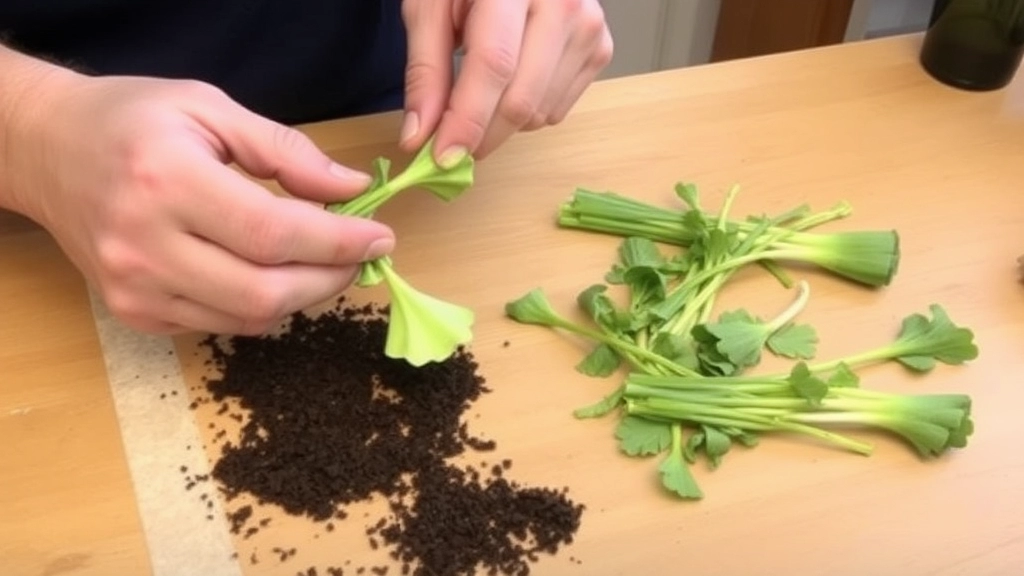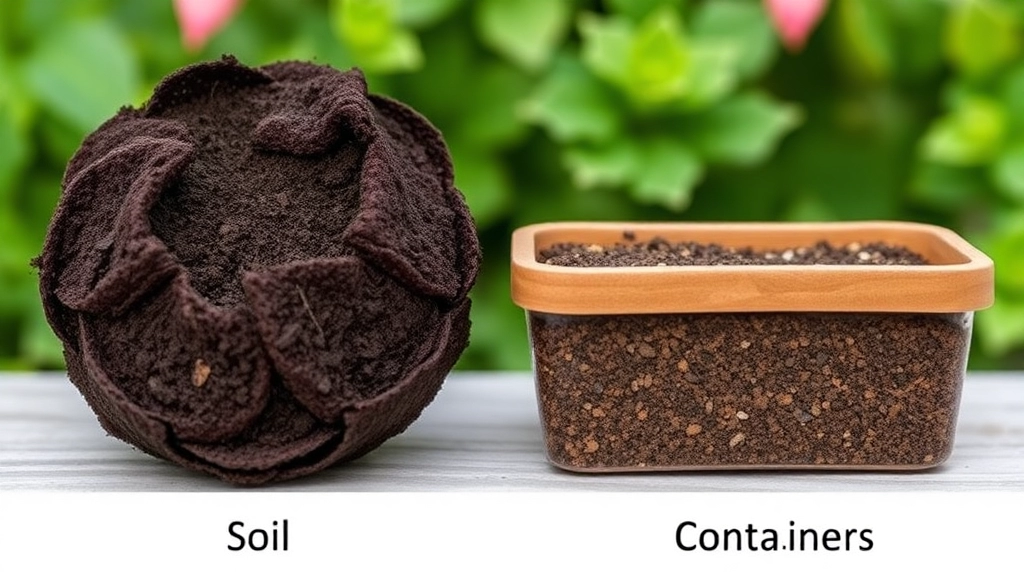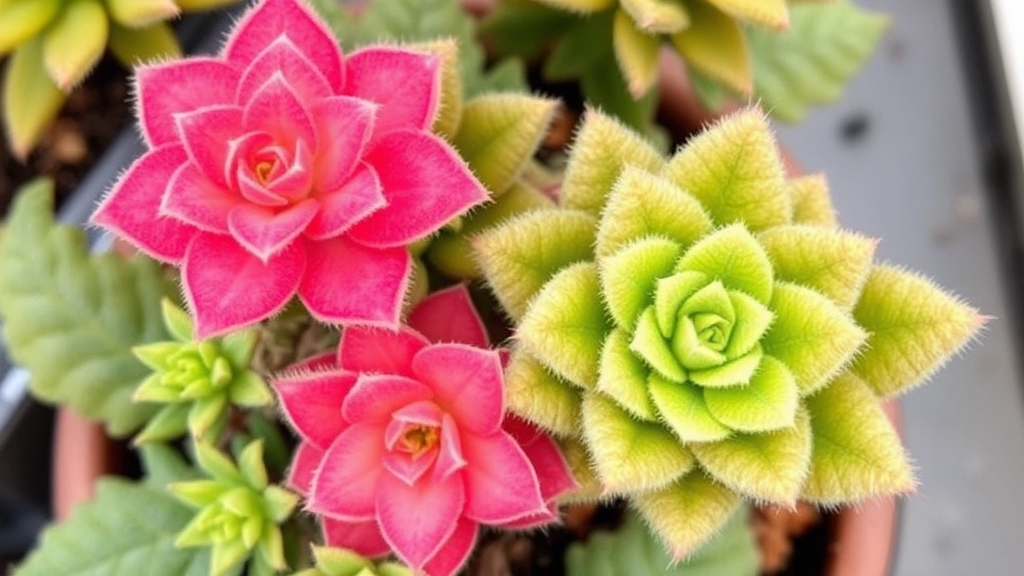Fuzzy Kalanchoe Propagation Guide
Hey there, plant enthusiasts! If you’ve ever tried fuzzy Kalanchoe propagation, you know it can be a bit tricky but oh-so-rewarding. Let’s dive right into the steps to help you get those fuzzy leaves sprouting new roots in no time.
Steps for Propagation
- Snip a Healthy Leaf: Use clean scissors to cut a healthy leaf from your fuzzy Kalanchoe.
- Let it Dry: Allow the leaf to dry out for a couple of days to form a callous.
- Planting: Once it’s ready, place it on well-draining soil and mist it lightly.
- Watering: Keep the soil moist but not waterlogged.
Soon you’ll see tiny roots forming. Happy propagating!
Selecting Healthy Fuzzy Kalanchoe Cuttings
Are you struggling to find the right cuttings for propagating your Fuzzy Kalanchoe?
Selecting healthy cuttings is crucial for successful propagation.
Here are some key tips to ensure you choose the best cuttings:
- Look for Vibrant Leaves: Healthy cuttings should have firm, plump leaves that are free from discoloration or spots. For more detailed care tips, you can refer to our Kalanchoe Leaf Propagation Step-by-Step Guide.
- Check for Pests: Inspect the plant for any signs of pests or disease. Avoid cuttings from plants that show any signs of stress.
- Choose the Right Stem: Select stems that are at least 4-6 inches long. They should be robust and not overly woody. Learn more about optimal care in our How to Grow Kalanchoe from Leaf Cuttings Guide.
- Timing Matters: The best time to take cuttings is during the growing season, typically in spring or early summer.
Preparing the Cuttings for Propagation

So, you’ve picked out some healthy fuzzy Kalanchoe cuttings, and now you’re wondering how to get them ready for propagation.
Here’s the deal: Properly preparing your cuttings can make all the difference between success and failure.
Steps to Prepare Your Cuttings:
- Choose the Right Time:
- Early spring or early summer is the best time for cutting. The plant is in its growth phase, and the cuttings will root more easily.
- Use Clean Tools:
- Grab a sharp, clean knife or scissors. This helps prevent any nasty infections.
- Take the Cuttings:
- Cut a stem about 4-6 inches long. Aim for a section with several leaves.
- Make the cut just below a leaf node. This is where roots will sprout.
- Remove Lower Leaves:
- Strip off the leaves on the bottom half of the cutting. This prevents them from rotting in the soil.
- Let Them Callous:
- Place the cuttings in a dry, warm spot for a day or two. This helps form a protective layer over the cut end, reducing the risk of rot when you plant them.
- Optional: Use Hormone Powder:
- If you want to give your cuttings a boost, dip the cut end in rooting hormone. It can encourage faster root growth.
After selecting healthy cuttings, the next step is to determine the best rooting methods for your Fuzzy Kalanchoe.
Many plant enthusiasts often wonder which technique will yield the best results.
1. Water Propagation
– **Choose a Container:** Use a glass jar or vase to hold the cuttings.
– **Submerge Properly:** Place the cuttings in water, ensuring that only the stem is submerged, while the leaves remain above.
– **Change Water Regularly:** Refresh the water every few days to prevent stagnation.
– **Monitor Root Growth:** Expect roots to develop within a couple of weeks.
2. Soil Propagation
– **Select the Right Soil:** Use a well-draining potting mix, ideally a cactus or succulent blend.
– **Insert Cuttings:** Make a small hole in the soil and gently place the cutting in, ensuring it stands upright.
– **Avoid Overwatering:** Water lightly after planting, allowing the soil to dry out between waterings.
– **Provide Humidity:** Covering the pot with a plastic bag can help maintain humidity, but ensure there’s airflow to prevent rot.
3. Direct Planting
– **Cut and Dust:** After cutting, allow the stem to callous over for a day or two. Dust the cut end with rooting hormone for better results.
– **Plant in Soil:** Directly insert the calloused cutting into the soil mix.
– **Water Sparingly:** Similar to soil propagation, avoid overwatering and let the soil dry out between waterings.
Each method has its advantages, and your choice may depend on personal preference or available resources. For more detailed tips on caring for your plants, you might find this [complete guide to Kalanchoe care](https://planthq.org/caring-for-your-kalanchoe-succulent-a-complete-guide/) helpful. Additionally, if you’re interested in specific varieties, check out this [Kalanchoe succulent identification guide](https://planthq.org/kalanchoe-succulent-identification-guide-top-varieties-traits/).
Soil and Container Selection

When it comes to propagating Fuzzy Kalanchoe, the right soil and container can make all the difference. You might be wondering, “What type of soil should I use?” or “Is my container suitable for propagation?” Let’s break it down.
Choosing the Right Soil
Fuzzy Kalanchoe thrives in well-draining soil. Here are some key points to consider:
- Cactus or Succulent Mix: A pre-mixed cactus or succulent soil is ideal. These blends are designed to drain quickly, preventing root rot.
- Additives: You can enhance drainage by mixing in perlite or coarse sand. This helps maintain aeration around the roots.
- pH Level: Aim for a slightly acidic to neutral pH (around 6.0 to 7.0) to promote healthy growth.
Selecting the Right Container
Your container choice is equally important. Here’s what to keep in mind:
- Drainage Holes: Always opt for containers with drainage holes. This prevents excess water from sitting at the bottom, which can lead to root rot.
- Size Matters: Choose a container that isn’t too large. A small pot allows the cuttings to establish roots without drowning in excess soil.
- Material: Terracotta pots are excellent for succulents as they are porous and allow moisture to evaporate. Plastic pots are lighter and retain moisture longer, so use them with caution.
After selecting healthy cuttings and preparing them for propagation, understanding the watering and light requirements for your Fuzzy Kalanchoe is crucial for successful growth.
### Watering Your Fuzzy Kalanchoe
One of the most common concerns for plant enthusiasts is how much water their plants need. For Fuzzy Kalanchoe, it’s essential to strike the right balance. Here are some key points to consider:
– **Soil Moisture:** Allow the top inch of soil to dry out before watering again. This prevents root rot, which is a significant threat to succulents.
– **Watering Frequency:** During the growing season (spring and summer), water every 2-3 weeks. In the dormant period (fall and winter), reduce this to once a month.
– **Watering Method:** Use the soak-and-dry method. Water thoroughly until it drains out of the bottom, then wait until the soil is dry before watering again.
### Light Requirements for Fuzzy Kalanchoe
Light plays a vital role in the health of your Fuzzy Kalanchoe. If you’re wondering how to provide the best lighting conditions, consider these tips:
– **Bright, Indirect Light:** Place your plant in a spot where it receives bright, indirect sunlight. Direct sunlight can scorch the leaves.
– **Duration:** Aim for about 6 hours of light daily. A south-facing window is often ideal.
– **Signs of Insufficient Light:** If your plant becomes leggy or the leaves lose their vibrant colour, it may not be getting enough light.
For more detailed information on how to care for this type of plant, you can check out the [Ultimate Guide to Fuzzy Kalanchoe Care Tips](https://planthq.org/ultimate-guide-to-fuzzy-kalanchoe-care-tips/). Additionally, if you’re interested in other species, the [Discover 150 Species of Kalanchoe Succulent Plants](https://planthq.org/discover-150-species-of-kalanchoe-succulent-plants/) article is a great resource.
Common Propagation Issues and Solutions

So, you’ve got your Fuzzy Kalanchoe cuttings ready, but now you’re facing some hiccups in the propagation process.
Sound familiar?
No worries, you’re not alone! Many plant enthusiasts encounter similar challenges. Here are some common issues and straightforward solutions to keep your cuttings thriving.
1. Cuttings Rotting
Issue: This tends to happen if the cuttings are kept too wet or in poorly draining soil.
Solution:
- Use well-draining soil: A mix designed for succulents works wonders.
- Allow cuttings to callous: Let them dry out for a few days before planting.
- Check drainage: Ensure your container has drainage holes.
2. Slow or No Root Growth
Issue: Sometimes, cuttings take their sweet time to develop roots.
Solution:
- Warm environment: Keep your cuttings in a warm spot to encourage growth.
- Humidity: A humidity dome can help, but don’t let them sit in water.
- Patience: It can take a few weeks, so hang tight!
3. Leaves Wilting or Dropping
Issue: Wilting leaves can be a sign of stress.
Solution:
- Adjust watering: Make sure you’re not over or under-watering.
- Proper light: They need bright, indirect light. Too much direct sun can scorch them.
- Check for pests: A quick inspection can save your cuttings from unwanted visitors.
4. Fungal Issues
Issue: Fungi love damp conditions, and sometimes they can take hold.
Solution:
- Air circulation: Ensure good airflow around your cuttings.
- Remove affected leaves: If you spot any signs of fungus, snip them off immediately.
- Use a fungicide: If things get out of hand, a gentle fungicide can help.
5. Stunted Growth
Issue: Your cuttings might seem to be stuck in time.
Solution:
- Nutrient boost: A diluted succulent fertiliser can kick-start growth.
- Reassess light: If they’re not getting enough light, they won’t thrive.
- Repot if necessary: Sometimes, they just need a bigger home.
Tips for Successful Fuzzy Kalanchoe Growth
As you embark on your journey to propagate and nurture Fuzzy Kalanchoe, it’s essential to keep in mind some practical tips that will ensure your plant thrives.
Are you wondering why your cuttings aren’t taking root or why your Kalanchoe isn’t blooming? These common concerns can be addressed with a few straightforward strategies.
- Choose the Right Environment:
- Fuzzy Kalanchoe prefers bright, indirect sunlight.
- Avoid placing it in direct sunlight, which can scorch the leaves.
- Maintain Optimal Temperature:
- Keep your plant in a warm environment, ideally between 18-24°C.
- Protect it from cold drafts.
- Use Well-Draining Soil:
- A cactus or succulent mix is perfect for Fuzzy Kalanchoe.
- Ensure the pot has drainage holes to prevent root rot.
- Water Sparingly:
- Allow the soil to dry out completely between waterings.
- Overwatering is a common mistake that can harm your plant.
- Fertilize Wisely:
- Use a diluted, balanced fertilizer during the growing season (spring and summer).
- Avoid fertilizing in the dormant months.
- Prune Regularly:
- Trim any dead or yellowing leaves to promote healthy growth.
- This also encourages bushier growth.
- Monitor for Pests:
- Keep an eye out for common pests like mealybugs and aphids.
- Treat infestations promptly with insecticidal soap.
By following these tips, you can create an ideal environment for your Fuzzy Kalanchoe to flourish. For more detailed advice on different Kalanchoe varieties, check out our guide on Kalanchoe Tomentosa varieties. Additionally, if you’re dealing with specific issues such as leaf discoloration, our article on why Kalanchoe leaves turn red offers valuable insights.
Frequently Asked Questions (FAQs) on Fuzzy Kalanchoe Propagation
What is the best time to take cuttings for Fuzzy Kalanchoe propagation?
Early spring or early summer is the ideal time to take cuttings. The plant is in its growth phase, making it easier for the cuttings to root.
What tools should I use to take cuttings?
Use a sharp, clean knife or scissors to take cuttings. Clean tools help prevent infections.
How long should the cuttings be?
Cut a stem about 4-6 inches long, aiming for a section with several leaves. Make the cut just below a leaf node.
Why is it important to let the cuttings callous?
Allowing the cuttings to callous for a day or two helps form a protective layer over the cut end, reducing the risk of rot when planted.
Should I use rooting hormone powder?
Using rooting hormone powder is optional but can encourage faster root growth.
What type of soil is best for propagating Fuzzy Kalanchoe?
A well-draining soil mix, such as a cactus or succulent mix, is ideal. Adding perlite or coarse sand can further enhance drainage.
What kind of container should I use?
Choose a container with drainage holes to prevent excess water from sitting at the bottom. Terracotta pots are excellent due to their porosity, but plastic pots can also be used with caution.
Why are my cuttings rotting?
Rotting can occur if the cuttings are kept too wet or in poorly draining soil. Ensure you use well-draining soil and let the cuttings callous before planting.
Why are my cuttings not developing roots?
Root growth can be slow. Ensure the cuttings are in a warm environment, maintain humidity, and be patient as it can take a few weeks.
What should I do if the leaves are wilting or dropping?
Wilting leaves can indicate stress. Adjust your watering, ensure proper light, and check for pests.
How can I deal with fungal issues?
Ensure good air circulation around your cuttings, remove affected leaves immediately, and use a gentle fungicide if necessary.
Why is the growth of my cuttings stunted?
Stunted growth can be due to a lack of nutrients or light. Use a diluted succulent fertilizer, reassess light conditions, and consider repotting if necessary.
References
-
How to Propagate Kalanchoe Cuttings
-
The Spruce: Growing Kalanchoe
-
Better Homes & Gardens: Kalanchoe
